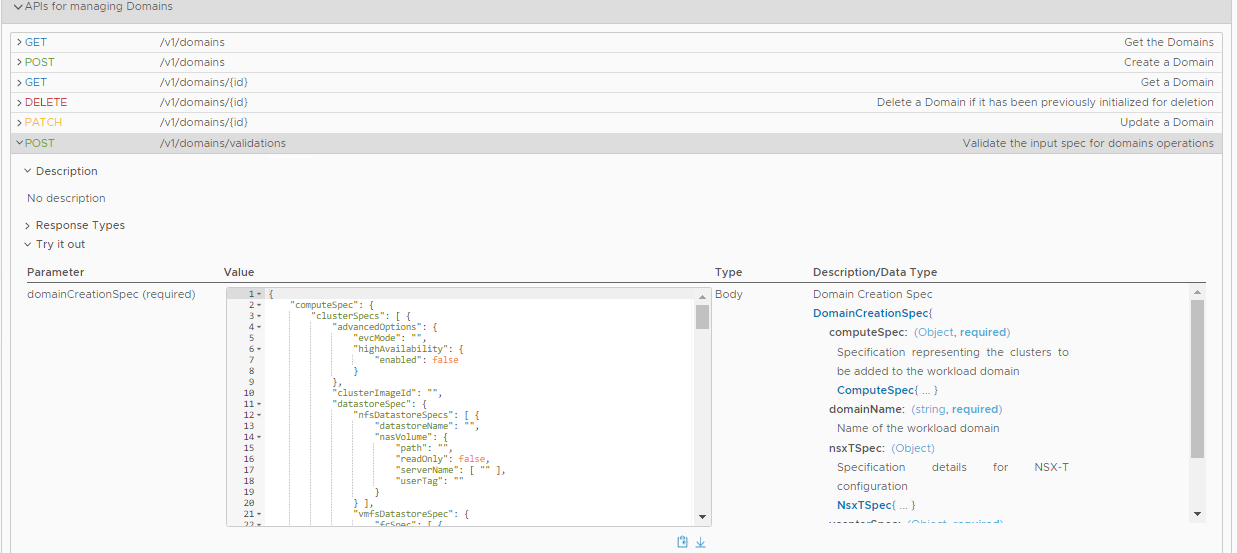If you want to create a VI workload domain with more than one vSphere Distributed Switch (vDS) or use ESXi hosts with more than two pNICs, you must use the VMware Cloud Foundation API.
This procedure uses the domainCreationSpec to create a new VI workload domain using the VMware Cloud Foundation API. It focuses on two specific sections of the domainCreationSpec that allow you to create a VI workload domain with more than one vDS or use ESXi hosts with more than two pNICS; hostSpecs and vdsSpecs.
ssoDomainSpec. All components in the management domain must be upgraded to
VMware Cloud Foundation 5.0 before you can create a new SSO domain.
You can use the VMware Cloud Foundation API to run multiple POST /v1/domains tasks in parallel. If the VI workload domains you are creating will use an existing NSX instance, that NSX instance must already be part of a successfully deployed workload domain.
| Two vSphere Distributed Switches |
|
| Four pNICs |
|
| pNIC to vDS mapping |
|
| vDS to traffic type mapping |
|
Prerequisites
Procedure
Example
{
"domainName" : "sfo-w01",
"vcenterSpec" : {
"name" : "sfo-w01-vc01",
"networkDetailsSpec" : {
"ipAddress" : "10.0.0.43",
"dnsName" : "sfo-w01-vc01.vrack.vsphere.local",
"gateway" : "10.0.0.250",
"subnetMask" : "255.255.255.0"
},
"rootPassword" : "<password>",
"datacenterName" : "sfo-w01-dc01",
"vmSize" : "medium",
"storageSize" : "lstorage"
},
"computeSpec" : {
"clusterSpecs" : [ {
"name" : "sfo-w01-cl01",
"hostSpecs" : [ {
"id" : "0ac30e66-7f65-4477-8331-80c3777c153c",
"licenseKey": "XXXXX-XXXXX-XXXXX-XXXXX-XXXXX",
"username" : "root",
"hostNetworkSpec" : {
"vmNics" : [ {
"id" : "vmnic0",
"vdsName" : "sfo-w01-cl01-vds01"
}, {
"id" : "vmnic1",
"vdsName" : "sfo-w01-cl01-vds01"
}, {
"id" : "vmnic2",
"vdsName" : "sfo-w01-cl01-vds02"
}, {
"id" : "vmnic3",
"vdsName" : "sfo-w01-cl01-vds02"
} ]
}
}, {
"id" : "05d1a8df-773a-46bb-8838-dcb5bb3358ea",
"licenseKey": "XXXXX-XXXXX-XXXXX-XXXXX-XXXXX",
"username" : "root",
"hostNetworkSpec" : {
"vmNics" : [ {
"id" : "vmnic0",
"vdsName" : "sfo-w01-cl01-vds01"
}, {
"id" : "vmnic1",
"vdsName" : "sfo-w01-cl01-vds01"
}, {
"id" : "vmnic2",
"vdsName" : "sfo-w01-cl01-vds02"
}, {
"id" : "vmnic3",
"vdsName" : "sfo-w01-cl01-vds02"
} ]
}
}, {
"id" : "2b8b770f-265d-4a63-b830-9c98038c81b2",
"licenseKey": "XXXXX-XXXXX-XXXXX-XXXXX-XXXXX",
"username" : "root",
"hostNetworkSpec" : {
"vmNics" : [ {
"id" : "vmnic0",
"vdsName" : "sfo-w01-cl01-vds01"
}, {
"id" : "vmnic1",
"vdsName" : "sfo-w01-cl01-vds01"
}, {
"id" : "vmnic2",
"vdsName" : "sfo-w01-cl01-vds02"
}, {
"id" : "vmnic3",
"vdsName" : "sfo-w01-cl01-vds02"
} ]
}
} ],
"datastoreSpec" : {
"vsanDatastoreSpec" : {
"failuresToTolerate" : 1,
"licenseKey" : "XXXXX-XXXXX-XXXXX-XXXXX-XXXXX",
"datastoreName" : "sfo-w01-cl01-ds-vsan01"
}
},
"networkSpec" : {
"vdsSpecs" : [ {
"name" : "sfo-w01-cl01-vds01",
"portGroupSpecs" : [ {
"name" : "sfo-w01-cl01-vds01-pg-mgmt",
"transportType" : "MANAGEMENT"
}, {
"name" : "sfo-w01-cl01-vds01-pg-vmotion",
"transportType" : "VMOTION"
}]
}, {
"name" : "sfo-w01-cl01-vds02",
"portGroupSpecs" : [ {
"name" : "sfo-w01-cl01-vds02-pg-vsan",
"transportType" : "VSAN"
} ],
"isUsedByNsxt" : true
} ],
"nsxClusterSpec" : {
"nsxTClusterSpec" : {
"geneveVlanId" : 2,
"ipAddressPoolSpec" : {
"name" : "static-ip-pool-01",
"subnets" : [ {
"ipAddressPoolRanges" : [ {
"start" : "10.0.11.50",
"end" : "10.0.11.70"
}, {
"start" : "10.0.11.80",
"end" : "10.0.11.150"
} ],
"cidr" : "10.0.11.0/24",
"gateway" : "10.0.11.250"
} ]
}
}
}
}
} ]
},
"nsxTSpec" : {
"nsxManagerSpecs" : [ {
"name" : "sfo-w01-nsx01a",
"networkDetailsSpec" : {
"ipAddress" : "10.0.0.44",
"dnsName" : "sfo-w01-nsx01a.vrack.vsphere.local",
"gateway" : "10.0.0.250",
"subnetMask" : "255.255.255.0"
}
}, {
"name" : "sfo-w01-nsx01b",
"networkDetailsSpec" : {
"ipAddress" : "10.0.0.45",
"dnsName" : "sfo-w01-nsx01b.vrack.vsphere.local",
"gateway" : "10.0.0.250",
"subnetMask" : "255.255.255.0"
}
}, {
"name" : "sfo-w01-nsx01c",
"networkDetailsSpec" : {
"ipAddress" : "10.0.0.46",
"dnsName" : "sfo-w01-nsx01c.vrack.vsphere.local",
"gateway" : "10.0.0.250",
"subnetMask" : "255.255.255.0"
}
} ],
"vip" : "10.0.0.166",
"vipFqdn" : "sfo-w01-nsx01.vrack.vsphere.local",
"licenseKey" : "XXXXX-XXXXX-XXXXX-XXXXX-XXXXX",
"nsxManagerAdminPassword" : "<password>",
"formFactor" : "large"
}
}
